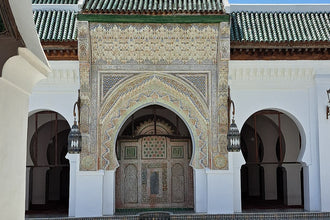
Lion of Babylon
The Lion of Babylon, also known as the Lion of Mesopotamia, holds deep historical and cultural significance for present-day Iraqis. It is a representation of the ancient city of Babylon, once a powerful and influential center of civilization in Mesopotamia. The lion, a symbol of strength and courage, was a common motif in Babylonian art, reflecting the power and majesty of the city and its rulers.
The exact date of the construction of the Lion of Babylon is unknown but is believed to have been during the reign of King Nebuchadnezzar II (605-562 BCE), a powerful ruler of the Neo-Babylonian Empire, who undertook extensive building projects in Babylon, including the famous Hanging Gardens built for his wife because she missed the green hills and valleys of her homeland.
Architecturally, the Lion of Babylon is associated with the Ishtar Gate, one of the eight gates of the ancient city of Babylon. The gate was adorned with elaborate glazed brick reliefs of dragons and bulls, with the image of a lion symbolizing the goddess Ishtar, for whom the gate was named. The lion was typically made of stone, such as basalt or limestone. These elements were not only decorative but also served a religious purpose, reinforcing the importance of Ishtar in Babylonian mythology.
When Islam spread to Iraq and the rest of the Middle East in the 7th century, the Lion of Babylon and other ancient artifacts from the Babylonian and Assyrian periods were preserved out of respect for the cultural heritage of the conquered lands. However, over the centuries, these artifacts suffered damage due to warfare, natural disasters, or neglect. Today, the Lion of Babylon, along with other ancient artifacts from Mesopotamia, is considered a national treasure and efforts are being made to protect it.
Abu at-Tayyib Ahmad ibn al-Husayn al-Mutanabbi | أبو الطيب أحمد بن الحسين المتنبي
Abu at-Tayyib Ahmad ibn al-Husayn Al-Mutanabbi, born in 10th century Kufa, Iraq, is revered as one of history's greatest Arab poets, earning the title "Oracle of the Arabs" for his mastery of Arabic language and profound, eloquent verses. His poetry, focusing on themes of heroism, honor, and life's complexities, reflects the tumultuous political and social landscape of his era. Al-Mutanabbi's works were highly sought after by rulers and patrons for their literary value as well as their ability to inspire and influence, solidifying his legacy as a prominent figure in the cultural and political spheres of the Islamic Golden Age and transcending time and place to remain revered in the Arab world and beyond.
Al-Mutannabi wrote the following lines while traveling through “Bawwan” on the way to Shiraz in the Fars Province under Buyid rule and his poem became the anthem for every Arab feeling like a stranger in a foreign land. In describing its great beauty, Al-Mutannabi refers to King Soloman — known in the Hebrew Bible to Jews and Christians for his wisdom and to Muslims as a prophet of Islam who could speak the languages of the animals and the djinn — to emphasize that even he would need an interpreter in these lands.
مَغَاني الشِّعْبِ |from The Melodies of the Valleys
مَغاني الشَعبِ طيباً في المَغاني
The melodies of the valleys are sweet in houses of rest
بِمَنزِلَةِ الرَبيعِ مِنَ الزَمانِ
As spring is in time
وَلَكِنَّ الفَتى العَرَبِيَّ فيها
But here the Arab youth is
غَريبُ الوَجهِ وَاليَدِ وَاللِسانِ
A stranger in appearance, hand, and tongue
مَلاعِبُ جِنَّةٍ لَو سارَ فيها
Playgrounds of the djinn, were Suleiman to walk through them
سُلَيمانٌ لَسارَ بِتَرجُمان
He would walk with an interpreter










